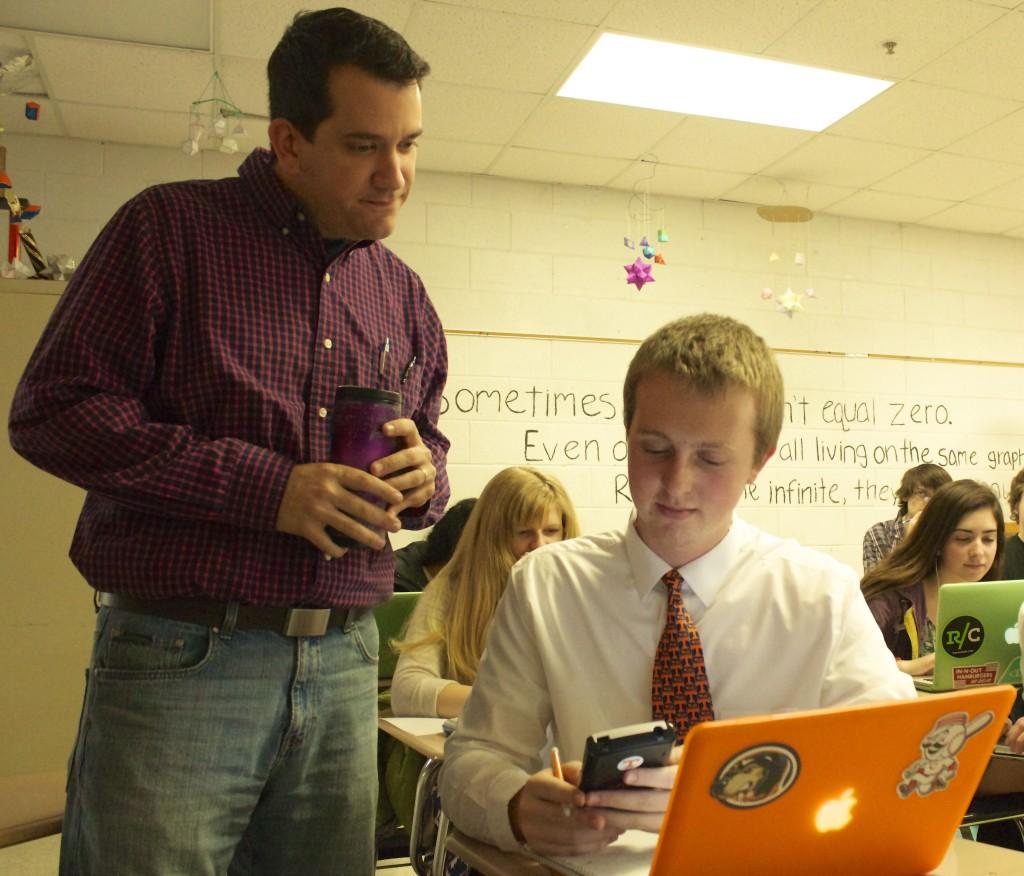Teachers exploring flip side of using technology inside of classroom
Bearden math teacher Mr. Richard Robinson works with senior Bryce Edwards in a flipped classroom scenario.
Attempting to find interesting, new ways to present information can be challenging at a time when technology runs rampant and the only thing on a typical teenager’s mind is checking their Instagram or Twitter to see how many likes or favorites their latest social media post has received.
At Bearden, teachers are seeking to use technology in new ways to engage students in learning by implementing a new teaching style: the flipped classroom.
The flipped classroom is a concept that takes two learning essentials – lecture and practice – and changes the location where these tasks are performed. In a typical classroom setup, lectures occur in class while practice is done at home. In the flipped classroom setup, it allows students to experience the lecture portion of class at home while the problem portion of class is addressed in-class.
“I like being able to have my teacher there when I have questions about a problem,” junior Lauren Leisenring said. “It’s nice that I don’t have to go home all confused after trying to learn something.”
The concept seems to fit well in the parameters of a math class, as students typically complain of experiencing issues on homework due to a concept in class that may not have been clear, or they forgot how to do the problem after the instruction of the teacher. The flipped classroom allows teachers to work more hand-in-hand with students through such problems.
“I am able to get around more one-on-one with students in the classroom because I’m not spending my time instructing,” math teacher Mrs. Susan Bothman said. “I’m spending my time assessing that learning, whether that learning is taking place.”
Technology is a big part of making the flipped classroom possible as it gives students the necessary tools to experience a lecture on a topic at home. The distribution of MacBook Pros to every student has given some teachers the push needed in order to make the switch to the flipped classroom.
While technology is helpful, and essential to the flipped classroom concept, it also contributes to the difficulties experienced in the process.
“Even though we have fantastic support staff, sometimes technology just doesn’t work when you need it to,” math teacher Mr. Richard Robinson said. “Java has been really annoying, specifically with [Honors Pre-Calculus], getting it to show discussions.”
Mr. Robinson has been using the flipped classroom concept in both his Honors Pre-Calculus class as well as his Advanced Algebra/Trigonometry class. These classes include an honors level class and a CP level class, allowing Mr. Robinson to experiment with integrating this teaching style into a variety of class types for students of all levels.
One observation Mr. Robinson has made is that CP level students seem more open-minded to the concept because honors level students tend to be more familiar and comfortable with a specific class structure that includes a teacher standing in front of a class and showing examples.
Another concept being tested by Mrs. Bothman is a partial flipped classroom. Her students have enjoyed the flipped classroom experience, but not as an all-the-time experience. To address this, Mrs. Bothman incorporates the flipped classroom once a week while the rest of the week is a regular classroom structure.
